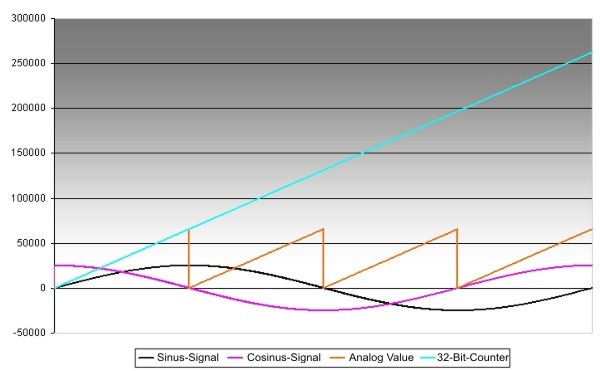Functioning IP5209
The IP5209-Bxxx-0000 input module evaluates the
1 VSS sine-cosine signals and
the IP5209-Bxxx-1000 input module evaluates the
11 µASS sine-cosine signals rom an appropriate
sensing switch or encoder. One signal period is represented in 10
bits, i.e. 1024 steps. Thus, for instance, a shaft encoder with
1024 signal periods yields approx. 2 million measured steps in
each rotation. This corresponds to a resolution of
21 bits.
In comparison with a conventional shaft encoder with digital rectangular signals there is a significant reduction in the transmission frequency for the same resolution. In place of transmission rates in the MHz range, the shaft encoder reaches no more than 100 kHz at 6000 rpm.
The IP5209-Bxxx Fieldbus Box allows a maximum input frequency of 100 kHz.
The module occupies 9 bytes of input data and 9 bytes of output data in the process image. Alternatively the process image can be set to 5 byte. The Latch value will not be transmitted in this case.

Process data
The signal period resolution is 10 bit, i.e. 1024 steps. It is represented as a 32 bit value. Bits 31 - 10 count the periods, Bit 9 and 8 the zero crossings and Bit 7-0 the interpolation within the quarter periods.
|
Bit |
31 ... 10 |
9 |
8 |
7 |
6 |
6 |
4 |
3 |
2 |
1 |
0 |
|
Name |
Period counter |
Zero crossings |
Resolution within the quarter period | ||||||||
|
Comment |
4.194.304 periods |
1024 steps within a period | |||||||||
The reference mark is represented in the latch words in the same way (see IP5209 Mapping).
Internal Functions
Resetting/setting the counter
The value of the counter is reset/set by setting the CNT_SET bit in the Control byte. The counter is set to the value of D0 - D3 of the output process image.
Save reference mark value (null latch)
Acquisition of the reference marks is activated, and the counter value that is valid when the reference marks (R+ and R-) are reached is written into the latch.
Status displays
Exceeding of the frequency limit is indicated in its status byte.